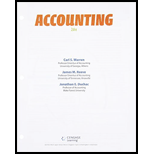
Concept explainers
Revenue journal;
Sage Learning Centers was established on July 20, 2016, to provide educational services. The services provided during the remainder of the month are as follows:
July 21. Issued Invoice No. 1 to J. Dunlop for $115 on account.
22. Issued Invoice No. 2 to K. Tisdale for $350 on account.
24. Issued Invoice No. 3 to T. Quinn for $85 on account.
25. Provided educational services, $300, to K. Tisdale in exchange for educational supplies.
27. Issued Invoice No. 4 to F. Mintz for $225 on account.
30. Issued Invoice No. 5 to D. Chase for $170 on account.
30. Issued Invoice No. 6 to K. Tisdale for $120 on account.
31. Issued Invoice No. 7 to T. Quinn for $105 on account.
Instructions
1. Journalize the transactions for July, using a single-column revenue journal and a two-column general journal. Post to the following customer accounts in the accounts receivable ledger, and insert the balance immediately after recording each entry: D. Chase; J. Dunlop; F. Mintz; T. Quinn; K. Tisdale.
2. Post the revenue journal and the general journal to the following accounts in the general ledger, inserting the account balances only after the last postings:
12 Accounts Receivable
13 Supplies
41 Fees Earned
3. a. What is the sum of the balances of the customer accounts in the subsidiary ledger at July 31?
b. What is the balance of the accounts receivable controlling account at July 31?
4. Assume Sage Learning Centers began using a computerized accounting system to record the sales transactions on August 1. What are some of the benefits of the computerized system over the manual system?
Trending nowThis is a popular solution!

Chapter 5 Solutions
Bundle: Accounting, Loose-Leaf Version, 26th + CengageNOWv2, 2 term Printed Access Card
- I need help finding the accurate solution to this general accounting problem with valid methods.arrow_forwardPlease provide the correct solution to this financial accounting question using valid principles.arrow_forwardI am looking for help with this general accounting question using proper accounting standards.arrow_forward
- Please provide the correct answer to this general accounting problem using accurate calculations.arrow_forwardPlease explain the solution to this financial accounting problem with accurate explanations.arrow_forwardPlease explain the correct approach for solving this general accounting question.arrow_forward
- I need help with this financial accounting problem using accurate calculation methods.arrow_forwardCan you help me solve this financial accounting question using valid financial accounting techniques?arrow_forwardPlease provide the solution to this financial accounting question using proper accounting principles.arrow_forward
 Financial AccountingAccountingISBN:9781305088436Author:Carl Warren, Jim Reeve, Jonathan DuchacPublisher:Cengage LearningCentury 21 Accounting Multicolumn JournalAccountingISBN:9781337679503Author:GilbertsonPublisher:Cengage
Financial AccountingAccountingISBN:9781305088436Author:Carl Warren, Jim Reeve, Jonathan DuchacPublisher:Cengage LearningCentury 21 Accounting Multicolumn JournalAccountingISBN:9781337679503Author:GilbertsonPublisher:Cengage Financial AccountingAccountingISBN:9781337272124Author:Carl Warren, James M. Reeve, Jonathan DuchacPublisher:Cengage Learning
Financial AccountingAccountingISBN:9781337272124Author:Carl Warren, James M. Reeve, Jonathan DuchacPublisher:Cengage Learning- Principles of Accounting Volume 1AccountingISBN:9781947172685Author:OpenStaxPublisher:OpenStax College
 College Accounting, Chapters 1-27AccountingISBN:9781337794756Author:HEINTZ, James A.Publisher:Cengage Learning,
College Accounting, Chapters 1-27AccountingISBN:9781337794756Author:HEINTZ, James A.Publisher:Cengage Learning,





